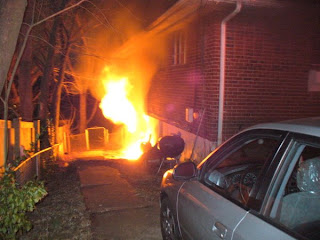
Getting Closer...
In part one of “Check your Dance Card” we discussed a few items to take a look at before we enter the fire building and start our dance with the “beauty of fire.” In part 2, we will discuss a few more specifics that we should note as we enter the structure. Make no mistake, a constant review of this Dance Card is a must for all members… take mental notes of what you see. You’re going to want to come home from your latest "dance" and tell all your friends all about this“beauty.”
"Ok, let's move" the boss said, after what seemed like an eternity to you. The reality, it was only mere seconds. We all know that reality is often suspended when you are out on that dimly lit dance floor. You, you’re an eager beaver, and chomping at the bit to get on with this next one. Your Officer is more cautious; he’s been burned by this “beauty” before. He remembers the sting of her touch, especially if you are caught moving too quickly on the dance floor. He is trying to show you the patience required, but you are still rather wet behind the ears and excitable…
This “beauty of fire” doesn’t make it easy; she beckons you closer with her dancing flames and warm lustrous glow. Again, the Officer reels you back in…one more review before we hit the dance floor.
As you enter the fire building…
1. WHAT TYPE OF STAIRS SERVICE THE BUILDNG?
Generally we have 2 types of tread design (on the staircase steps) and 2 types of staircases. They are either “Open” (having no sides, walls or doors at the top or bottom) or “Enclosed” (having sides, walls and doors at the top and bottom). Open tread and open staircases allow the passage of smoke, heat and fire to the floors above and are not friendly to our operation. Enclosed steps and enclosed staircases reduce the chances of fire spread in the building (if the doors are to remain in the closed position). It may be wise to announce the style and type of stairs to other units as they arrive, so that they know what to expect. This is of particular importance when in larger multiple dwellings or garden apartments and there are isolated, wing, or multiple staircases that serve specific lines of apartments (i.e. do not transverse the entire building). “Ladder X to Command; we have enclosed wing stairs, we will be using the A wing stairs to reach the fire apartment.”
2. IS THERE A WELL H*** TO USE FOR THE STRETCH
The presence of a “Well H***” the space created between the landing section of the stairs and the run of the steps themselves can be utilized for quick hoseline advancement. It must be rehearsed prior with the Engine Co. to achieve maximum effect. It reduces the amount of hose needed to be humped up the treads of the steps and around each newel post (i.e. 1-50’ length can travel vertically 5 floors in the well versus 1 length per floor if going up and around each set of steps, newel posts and associated landings). “Engine 22 to members, there is a well” should be enough to let the members know.
3. HOW MANY APARTMENTS ON THE FLOOR
A quick stop on the floor below can get you a lay of the land. If you bypassed the lobby and forgot to count mailboxes, count the number and note location of the apartments that you see. Remember that depending of the way the stairs run (scissor, return etc), they may be slight variations in the layout when you get on the fire floor.
4. VERIFY FIRE FLOOR AND APARTMENT NUMBER/LETTER
What may have appeared to be a fire on the 3rd floor from the street may turn out to on the second floor depending on the buildings configuration as it relates to the street level. Some buildings have lobby entrances that are raised above street level, which may change your initial fire floor notifications. Verify the fire floor and announce the apartment number or letter over the air, so that those who may be going above can pinpoint the direction they need to head.
Open Tread and Open Stairs
Views: 504
Comment
© 2025 Created by fireeng.
Powered by
![]()




You need to be a member of Fire Engineering Training Community to add comments!
Join Fire Engineering Training Community